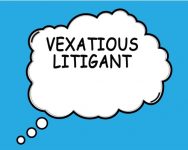How to Deal with a Vexatious Litigant

Going through court proceedings can be costly, stressful, frustrating and time-consuming – especially if you are the target of a baseless or false claim.
Those who repeatedly institute such claims not only put others through unnecessary hardship, they add to the pressure of our already overburdened court system – resulting in unnecessary delays for those with legitimate cases.
To address the issue, parliament has passed legislation to prohibit the misuse of the court process.
Vexatious Proceedings Act
Section 6 of the Vexatious Proceedings Act 2008 (NSW) defines ‘vexatious proceedings’ as those which are:
- an abuse of the process of a court or tribunal, and
- instituted to harass or annoy, to cause delay or detriment, or for another wrongful purpose, and
- instituted or pursued without reasonable ground, and
- conducted in a way so as to harass or annoy, cause delay or detriment, or achieve another wrongful purpose.
Section 8 prescribes a mechanism whereby the Supreme Court or Land and Environment Court can declare a person to be a ‘vexatious litigant’.
If a person is declared vexatious, the Supreme Court has the power to:
- order that existing proceedings in NSW be ‘stayed’ (ie not go ahead),
- prohibit the person from instituting proceedings in NSW, or
- make any other order it considers appropriate in relation to the person.
The Land and Environment has the power to:
- stay all or part of any proceedings in the court,
- prohibit the person from commencing proceedings in the court, or
- make any other order it considers appropriate in relation to proceedings by the person in the court.
The court can declare a person to be a vexatious by its own motion, or upon application by:
(a) the Attorney General,
(b) the Solicitor General,
(c) the Court Registrar,
(d) a person against or in relation to whom another person has instituted or conducted vexatious proceedings, or
(e) a person who, in the opinion of the court, has a sufficient interest in the matter.
In order to make orders against a person, the court must be satisfied that he or she “has frequently instituted or conducted vexatious proceedings in Australia”, or “acting in concert with a person who is subject to a vexatious proceedings order… has instituted or conducted vexatious proceedings in Australia”.
What are frequent claims?
In the High Court case of Jones v Cusack [1992] HCA 40, Justice Toohey held that 2 summonses and 3 notices of motion in 6 years “readily answer that description”.
And in case of Attorney General of NSW v Wilson [2010] NSWSC 1008, the Supreme Court remarked:
“In the light of the fact that most of the proceedings instituted by Mr Wilson derived from his dissatisfaction with the result in his first claim against St George Bank, the approach in Brogden v Attorney-General that the number of proceedings can be quite small [emphasis added] if those proceedings attempt to re-litigate matters already determined against the claimant is applicable when determining whether proceedings have been instituted “frequently”.
In AG v Chan [2011] NSWSC 1315 (at 37), the Supreme Court noted that:
“[t]he term “frequently” is relative and must be looked at in the context of the litigation being considered. It is not necessary for a person to commence a large number of proceedings in order for it to be said that the person has done so frequently.”
Declaring a person to be vexatious
As to the exercise of discretion to make an order under the Act, Justice Perram J remarked in Official Trustee in Bankruptcy v Gargan (No 2) [2009] FCA 398 at [12]:
“Because of the protective nature of the jurisdiction it is also relevant to know the extent of the damage and inconvenience the litigant’s forays into the courts have caused, pecuniary or otherwise.”
The court is to have regard to the result of the proceedings and, where appropriate, the findings of, and views expressed by, the various judicial officers who dealt with them
So if you feel that you are the target of a person who has “frequently” commenced unfounded proceedings against you or others in the past, there may be relief at hand.







